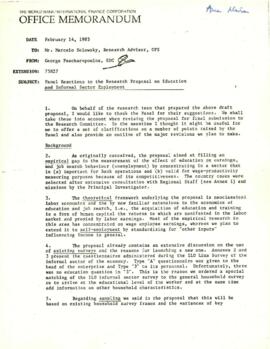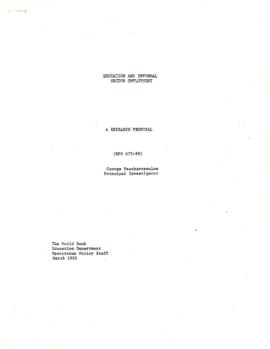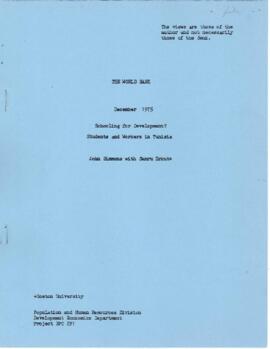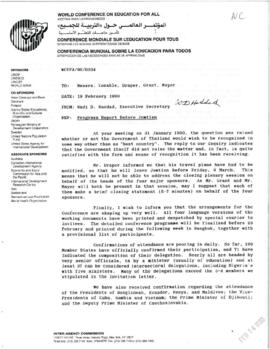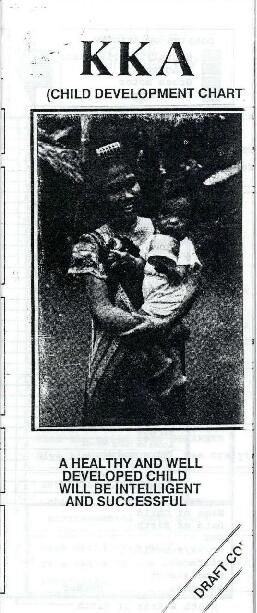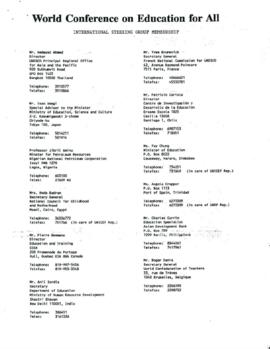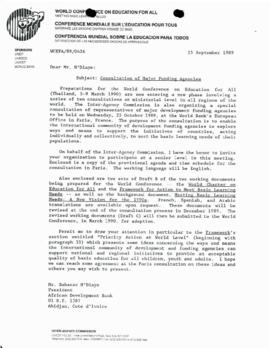Identity area
Reference code
Title
Date(s)
- 1964 - 2013 (predominant 1972 - 2006) (Creation)
Level of description
Fonds
Extent and medium
201.59 linear feet of textual records; 8 computer disks (5 5.25", 2 8", 1 3.5")
Context area
Name of creator
Biographical history
The World Bank first began lending for education projects in fiscal year 1963 with an International Development Association (IDA) credit to Tunisia. The credit financed the extension of a teacher's training college and the construction and expansion of secondary and middle schools, including a new secondary school for girls. In October of 1963, a memorandum from the President on Proposed Bank/IDA Policies in the Field of Education was issued in which the basic policy on education projects was set forth. Initially, the objectives were to promote educational planning, build infrastructure, and attract additional capital investment from other donor agencies.
1963 - 1972
Functional responsibility for education-related activities was first articulated in the organizational structure of the World Bank in early 1963 with the creation of the Education Division in the new Department of Technical Operations. Ricardo Diez-Hochleitner was appointed chief of the Education Division that was charged with appraisal of educational projects submitted for financing, and for assisting countries to plan their educational investments along lines which will promote their economic development. The Technical Operations Department became the Projects Department (PRJ) on January 18, 1965, and was responsible for: the identification, appraisal and supervision of projects; policy formulation and research; and advice in support of the operational activities of the area departments. The Projects Department initially had five subordinate divisions: Agriculture Division (PRJAG); Public Utilities Division (PRJPU); Industry Division (PRJIN); Transportation Division (PRJTP); and Education Division (PRJED).
On November 1, 1968, the Projects Department was terminated and the subordinate divisions were upgraded to the department level. The Education Department (EDP) was one of the newly created departments along with the Departments of Agriculture (AGP), Transportation (TRP), and Public Utilities (PBP). Duncan S. Ballantine was the department's director and served until 1977. Initially, EDP had two divisions: Education Division 1 (EDP1) and Education Division 2 (EDP2). In 1970, Education Division 3 (EDP3) was created.
From 1968 until a Bank-wide reorganization in 1972, the individual Projects Departments reported to the Director of Projects (DRP), and were the primary Bank units responsible for the appraisal, negotiations, and supervision of operational project work in their respective sectors. The departments were specifically responsible for:
-
providing advice, conducting research, and monitoring developments in sector issues;
-
carrying out sector studies with the objective of identifying projects and determining priorities within sectors;
-
preparing policy papers outlining the basic principles and approaches of the Bank relating to project and sector work;
-
preparing guidelines and standards;
-
appraising proposed projects and supervising projects in execution;
-
assisting in the identification and preparation of projects;
-
providing operational support in the negotiation and administration of loans and credits; and
-
cooperating with other international agencies on programs of common interest.
In 1971, the Bank issued the first formal statement on the priority for education lending in an Education Sector Working Paper.
1972 - 1986
The Bank's massive reorganization in October 1972 attempted to more effectively fuse country knowledge with sector skills. Sectors with a sufficient number of experts and an established lending program, such as the Education Department, were largely decentralized. While maintaining a centralized core staff of department advisors, the majority of department staff were dispersed to regional project departments in newly established Regional Vice Presidencies. The remaining centralized staff made up the sector operating departments and performed advisory services for the Regions. They were responsible for improving and maintaining the quality of Bank lending and related operations through: formulating policies, methodology and guidelines; providing operational support and advice; and managing related programs of recruitment assistance, staff development and education. In the case of the decentralized sectors (Agriculture, Education, Public Utilities, Transportation and non-African Development Finance Companies), specialized personnel assigned to Central Projects Staff were loaned tothe Regions to work under the full operational control and direction of the appropriate regional Division Chief and mission leader for the duration of the assignment.
The Education Department, as well as other sector operating departments, reported to the newly created Vice President, Central Projects (CPSVP). The Vice President, Central Projects, replaced the previous Director, Projects (DRP), and reported to the Senior Vice President, Operations (SVPOP).
The 1974 Sector Working Paper that focused on education was published in December 1974 and introduced a new policy direction that emphasized the urgency for increased financing to improve access of the rural and urban poor to education, making curricula relevant to rural needs, and promoting functional adult literacy.
On July 1, 1977, the Education Department was assigned a new acronym (EDC) and a Training Unit (EDCTR) was established. On July1, 1983, three other units were created: Education Research Program (EDCRS); Education Operational Policy Program (EDCOP); and Education Project Related Training Program (EDCPT).
In late 1977, an External Advisory Panel of international experts in education was appointed by President McNamara to review the status of education in the developing world including the Bank's education and training lending and projects and recommend areas for future action. The panel was chaired by David E. Bell of the Ford Foundation. A report containing conclusions and recommendations was issued in 1978.
In 1979, the Education Sector Policy Paper was released. It emphasized primary education as the foundation of educational development and called for: improved access of girls and rural children to basic education; a limitation of additional investments in secondary and higher education; enhanced instructional quality by providing cost-effective school inputs and teacher training; improving internal efficiency; mobilizing community resources and the mass media; and building local institutions.
In fiscal year 1984, the sector adopted a plan to enhance Bank staff training and introduced four types of courses for sector staff centering on: introductory training for new staff; advanced training on project design and implementation; technical training; and cross-specialization, including education of non-educators.
In July 1984, EDC was renamed the Education and Training Department (EDT). In February 1985, the subordinate units of EDT were given the status of divisions. This resulted in: Research Division (EDTRS); Education Policy Division (EDTEP); and Project Related Training Division (EDTPT). EDTPT was subsequently terminated on July 1, 1986, and EDTEP received a new acronym (EDTPD) on July 30, 1986.
A major policy paper on Sub-Saharan Africa was released on January 27, 1988 titled "Education in Sub-Saharan Africa: Adjustment, Revitalization and Evaluation". The policy discussion brought together twenty-five donor governments and agencies in Paris to assist in developing strategies for educational reform in Africa. The paper identified common problems in educational development, provided comparative data and analytical toolsfor developing policies and procedures, and suggested specific policy directions by governments and donors.
1987 - 1996
On July 1, 1987, a Bank-wide reorganization resulted in the termination of almost all organizational units. The Vice Presidency, Sector Policy and Research (PRE), was established in May 1987, and reported to the Senior Vice President, Policy, Planning and Research (PPR). The PRE shed all responsibility for managing operational activities and focused completely on operational support, the formulation of Bank-wide sector policies, and overseeing the ex-post evaluation of Bank-wide sector work and lending. The PRE changed its acronym to PRS on January 1, 1990.
At the time of its creation, the PRE had five departments reporting to it including the new Population and Human Resources Department (PHR). This Department integrated the functions of EDT and the Population, Health and Nutrition Department (PHN); it also assumed responsibility for activities related to 'strengthening the role of women in development.' The Department had four divisions: Education and Employment Division (PHREE); Population, Health and Nutrition Division (PHRHN); Women in Development (PHRWD); and Welfare and Human Resources Division (PHRWH). On July 1, 1992, a Population Policy and Advisory Service Group (PPAS) was established in the Front Office of the Department to increase attention to population work. The PHR was responsible for:
-
formulating policies and strategies for human resource development and women in development, and developing new initiatives and Bank products;
-
conducting supporting research, including the improvement of research capabilities in developing countries, and management of external research funded through the Research Support Budget;
-
improving methodology and identifying best practices;
-
performing ex-post evaluation of the Bank's human resources sector work;
-
providing operational support;
-
liaising with non-Bank organizations and professionals in the field;
-
developing householddata on living standards; and
-
assisting in the recruitment and training of staff.
In 1991, the priority areas of education sector lending were:
-
improving the effectiveness and efficiency of primary education;
-
increasing the access of women and girls to education;
-
strengthening science and technology education;
-
improving the efficiency and flexibility of training systems;
-
strengthening the contributions of higher education and sciences and technology institutions to development; and
-
continuing support for project-related training and the development of sectoral training capacity.
On December 1, 1991, President Lewis Preston's first reorganization abolished all Senior Vice-Presidencies. The new Sector and Operations Policy Vice Presidency (OSP) was created and adopted functions previously supervised by Senior Vice Presidents, including the PHR. On January 1, 1993, as part of a larger initiative to align the Bank's organization with the priority areas of its poverty reduction effort, the Sector and Operations Policy Vice Presidency (OSP) was terminated. On January 1, 1993, as part of a larger initiative to align the Bank's organization with the priority areas of its poverty reduction effort, the Sector and Operations Policy Vice Presidency (OSP) was terminated. All research activities were removed from the departments in the Central Vice Presidencies, including PHR, and were consolidated under the Chief Economist and Vice President for Development Economics (DECVP). The Policy Research Department (PRD) under DECVP became the principal research arm of the Bank including responsibility for education and employment sector research.
OSP was replaced by three new thematic vice presidencies: Human Resources Development and Operations Policy (HRO), Finance and Private Sector Development (FPD), and Environmentally Sustainable Development (ESD).
During the 1993 reorganization, the PHR was terminated and its functions were split between a new Education and Social Policy Department (ESP) and a Population, Health and Nutrition Department (PHN). Both of these departments were placed in the HRO vice presidency along with an Operations Policy Department (OPR). The OPR absorbed the functions of: the former Central Operations Department (COD); the International Economic Relations Division (OPRIE); and the UN Office in New York (OPRNY) transferred from the External Relations Department (EXT).
On July 1, 1995, HRO became Human Capital Development and Operations Policy (HCO). At this time ESP was terminated; the education functions were moved into the new Human Development Department (HDD) which consisted of education as well as the previous Population, Health and Nutrition functions of PHN. The Social Policy function of ESP was moved into the new Poverty and Social Policy Department (PSP).
Among the major initiatives in the early 1990s was the World Conference on Education for All (WCEFA), an inter-agency initiative involving the Bank that began with a conference to focus on achieving universal basic education. The impetus for the conference was the United Nations General Assembly declaration of 1990 as International Literacy Year. WCEFA was held March 2-5, 1990, in Jomtien, Thailand and was co-hosted by the Bank. It brought together 155 governments, 33 intergovernmental bodies, and 125 nongovernmental organizations. Participants adopted the World Declaration on Education for All charter which outlined six goals designed to meet the learning needs of children, youth, and adults. A Framework for Action: Meeting Basic Learning Needs was also adopted. It outlined general priority actions for countries. At Jomtien, the Bank pledged to double its lending for education. WCEFA launched the international Education for All (EFA) program.
1996 - 2014
Beginning in September 1996 and into 1997, the thematic Vice Presidencies were reorganized to strike a better balance between country focus and sectoral excellence. The Human Development Network (HDN) was the first to be launched in the Bank-wide reorganization into networks to facilitate sharing of expertise and knowledge. Networks linked Bank-wide communities of staff working in the same field across organizational boundaries and with external partners. The networks formed a virtual overlay on the existing Bank organization, and were intended to link staff working in the same sectors throughout the Bank, whether the staff was located in the regions, in the Central Vice-Presidencies' Sector Departments, or other vice-presidencies.
Each of the three thematic Central Vice-Presidencies was transformed into the central units, or anchors, of each network and consisted of the existing sector departments. On a Bank-wide basis, sector specialists were grouped into regional sector units or into central sector departments that worked with country departments in a matrix relationship. Staff from the central sector departments could become part of the Regional operational teams when their sectoral expertise was required.
The work programs of Network staff focused on the following items.
-
Global knowledge - putting the best development knowledge in the hands of Bank task teams; ensuring that the knowledge base was accessible to external clients; and contributing to the growth of the knowledge base.
-
Enhanced skills - developing and providing content to training courses; establishing professional and technical standards for professional development.
-
Shared strategies - assisting regional and central units to develop a common sector agenda, and ensuring that skills are effectively deployed across the entire network. Network leadership assumed responsibility for global programs, sector strategy development and evaluation, strategic partnerships, and learning and dissemination.
-
Best teams and best practices - improving the Bank's flexibility and mobility by building stronger task teams and delivering higher quality products.
-
Institutional initiatives - providing substantial support for new Bank-wide initiatives, such as Social Development, Rural Development, Financial Sector, Anti-corruption, Human Resources, and Knowledge Partnerships.
The result of the 1997 restructuring was four networks: the Environmentally and Socially Sustainable Development Network (ESSD); the Finance, Private Sector Development, and Infrastructure Network (FPD); the Human Development Network (HDN); and the Poverty Reduction and Economic Management Network (PRM). Within the network, the Human Development Network Council was responsible for the overall management of HDN led by Chair, David de Ferranti (HDNVP), previously director of HDD.
As part of this reorganization, the HDD was broken into three teams and placed in HDN. The teams included: Education Team (HDNED); Health, Nutrition, and Population Team (HDNHE); and the Social Protection Team (HDNSP). In 2002 an HIV/AIDS Global Program Team (HDNGA) was created and added to the HDN, led by Adviser Dr. Debrework Zewdie (later director).
Also, as a result of the 1997 reorganization, sector boards were established within HDN and other sectors. Sector boards replaced the existing staffing groups and sector panels, but with expanded mandates to include achieving the network priorities. Each sector department had its own board, chaired by the sector director in the network anchor. The sector board was drawn from staff within the network, and was also comprised of representatives from the regions, non-regional functional departments (Development Economics and World Bank Institute), and the International Finance Corporation (IFC). The board was accountable to the network council and was supported by a secretariat. The role of the board was to set the strategy for the Bank's work in the sector, endorse business plans and budget, ensure the regions and anchor perspectives were in sync, and to oversee the outreach and partnerships for the sector, with the anchor staff often doing the day-to-day management and monitoring of global trust funds.
Among the Education Team's key initiatives during this period was the establishment of the Education Advisory Service (ESA) in fiscalyear 1997 to help staff leverage knowledge and information. An education management system was launched to respond to requests for Bank teams to locate consultants, learn about project experiences, improve project design, and implement projects. Clients included field mission teams, countries, and partner institutions. Also, the 1999 Education Sector Strategy paper was issued. Thestrategy focused on taking stock of global changes and progress in educational development as well as priorities and programs to help countries progress toward international education goals and improve the quality of teaching and learning.
The World Education Forum held in Dakar, Senegal in 2000 convened partners from government, UN agencies, the Bank, NGOs, and academia to determine the direction education was to take in the new millennium, both in their own countries and around the world. Ten years after Education for All (EFA), many countries were far from reaching the established goals. The commitment to achieve EFA by the year 2015 was affirmed at the Dakar forum. Bank President James D. Wolfensohn told the forum that no country with viable and sustainable plan for achieving EFA will be unable to implement it for lack of external resources.
In 2002, the Bank, with its development partners, established the Education for All Fast Track Initiative (EFA-FTI) to help low-income countries achieve free, universal basic education by 2015 pursuant to the United Nations' Millennium Development Goals (MDGs).
In 2011, the Education Sector Strategy 2020 "Learning for All" was launched. The strategy encouraged countries to invest in early childhood education to build foundational skills and lifelong learning, and to invest in efforts shown to improve learning. The EFA-FTI was also rebranded as the Global Partnership for Education and a Global Partnership for Education Fund (GPEF) was established as a Financial Intermediary Fund (FIF) to support its operations. The GPE secretariat was hosted by the Bank, within HDN.
2014
On July 1, 2014, a Bank-wide reorganization introduced by Bank President Jim Yong Kim restructured the Bank into fourteen Global Practices (GPs) and five Cross-Cutting Solution Areas (CCSAs). Sector staff from the Regional Vice Presidencies were removed and placed in the GPs or CCSAs. The GPs were responsible for each of the major thematic areas that the Bank supports through projects and functions as a vertical pillar of technical expertise. Responsibilities of the EDU GP include:
-
defining the strategic direction and the Bank's work in education with a view to supporting countries in ensuring improved education outcomes for all;
-
developing and deploying expertise globally;
-
delivering integrated solutions to client countries;
-
capturing and leveraging knowledge in education.
The Education Team (HDNED) established from the 1997 reorganization now became Education Global Practice (EDU)reporting to the Human Development Practice Group Vice Presidency (GGHVP). Claudia Costin was appointed senior director and Amit Dar, director. The senior director continued to lead the sector board. Nine Education Global Practice managers reporting to the director were responsible for the following regions divided into: Latin America and Caribbean, (HLCED); Middle East (HMNED); Europe and Central Asia (HECED); Africa 1 (HAEE1); Africa 2 (HAWE2); Africa 3 (HAWE3); South Asia (HSAED); East Asia and Pacific (HEAED), and Global Engagement and Knowledge unit (HEDGE).
Past directors or sector leaders are as follows:
1963 - 1964 Ricardo Diez-Hochleitner
1964 - 1977 Duncan S. Ballantine
1977 - 1978 Mats G. Hultin (acting)
1978 - 1987 Aklilu Habte
1987 - 1988 Wadi D. Haddad (senior adviser, Education under PHR director)
1989 - 1992 Adriaan M. Verspoor
1993 - 1994 Peter Russell Moock (manager, Education under ESP director)
1995 - 2000 Maris O'Rourke (senior adviser HDD then director HDNED 1997)
2000 - 2001 Bruno LaPorte and Marlaine Lockheed (acting)
2001 - 2008 Ruth Kagia
2009 - 2014 Elizabeth King
2014 - 2017 Claudia Costin
Repository
Archival history
Records in this fonds were transferred to the World Bank Group Archives either directly from the responsible sector unit, or by the Records Management Section responsible for the Bank's Central Files. In the case of the former, approved records retention and disposition schedules were used. Prior to the initiation of direct transfer of records to the Archives in the 1990s, the sector forwarded their records to the Bank's centralized filing unit. Following the closure of the semi-centralized Non-Regional Information Centers (NRIC) in July 1987, the centralized records were kept at the Bank's record center until they were accessioned into the custody of the Archives in 1994.
Immediate source of acquisition or transfer
Content and structure area
Scope and content
The fonds contains records predominantly created between 1972 and 2006 by Education Sector units. A small portion of records that date from the 1960s are external reports and other material used for reference by department staff. While sector records were maintained in the Bank-wide centralized filing system from the early years of operations in the 1940s until mid-1987 and some of these records remain part of the Central Files fonds, departments often kept separate working files. It is primarily the working files of the education sector that comprise the records in this fonds, along with records created after 1987 when recordkeeping responsibilities were turned over to the records-creating offices. See the arrangement note below for more information about the centralized files.
The records reflect the range of functional responsibilities within the sectors of education, employment, and training: including: producing studies and publications; policy and best practice development; operational support to theregions regarding Bank projects and quality review; maintaining Bank partnerships and sponsorship of joint programs with United Nations agencies and other organizations; managing and monitoring global trust funds; and participation or organization of conferences, training, and other learning events.
Appraisal, destruction and scheduling
Accruals
Accruals are expected.
System of arrangement
Bank sector departments forwarded their records to the Bank's centralized filing unit where they were arranged into the Bank-wide classification system. Certain "series" of records maintained in the semi-centralized Non-Regional Information Center (NRIC) that relate to a specific function or unit, in this case the Education Sector, were arranged in this functional department fonds when there was a clear distinction.
Original order of the records has been maintained.
Conditions of access and use area
Conditions governing access
Records are subject to the World Bank Policy on Access to Information.
Conditions governing reproduction
Records are subject to the Copyright Policy of the World Bank Group.
Language of material
- English
- French
- Spanish
- Arabic
- Swahili
- Persian
Script of material
Language and script notes
Physical characteristics and technical requirements
Finding aids
Allied materials area
Existence and location of originals
Existence and location of copies
Related units of description
Notes area
Alternative identifier(s)
Access points
Subject access points
Place access points
Name access points
Genre access points
Description control area
Description identifier
Institution identifier
Rules and/or conventions used
Internal World Bank Group Archives rules based on ISAD(G).
Disclosure status
Level of detail
Dates of creation revision deletion
10 July 2012, 26 May 2021



![United Nations Educational, Scientific and Cultural Organization [UNESCO] - IBRD - Cooperative Pr...](/uploads/r/world-bank-group-archives/5/5/0/550563cdd7e4c7791c8af31433e71d4dc7f526401d0be7f1db1d9eb6bd6d815f/wbg-archives-1105609_142.jpg)
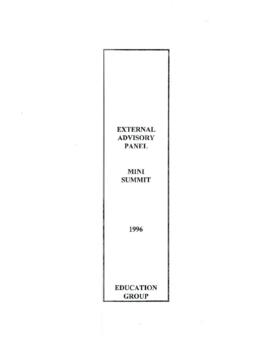
![United Nations Educational, Scientific and Cultural Organization [UNESCO] - Guidelines for Projec...](/uploads/r/world-bank-group-archives/1/6/3/1636ea22caf86ad9ffb526d291af86852ac26634ed9900bdf546496e6fbfb9f0/WorldBankGroupArchivesfolder30462982_142.jpg)
